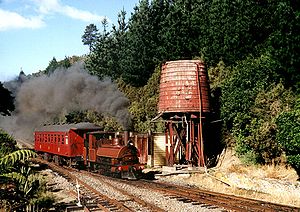- NZR C class (1873)
-
NZR C class (1873) 
C class loco 132 on the Silver Stream Railway, 6 March 2002 Power type Steam Builder Dübs & Co. (6),
Neilson & Co. (10)Serial number Dübs 800–804, 885,
Neilson 1764–1773Build date 1873–1875 Total produced 16 Configuration Originally 0-4-0ST
Rebuilt 0-4-2STGauge 3 ft 6 in (1,067 mm) Driver diameter 2 ft 6 in (0.762 m) Wheelbase Coupled: 6 ft 0 in (1.83 m),
Total: 13 ft 0 in (3.96 m)Length 21 ft 2 3⁄4 in (6.47 m) Weight on drivers 14.20 long tons (14.43 t) Locomotive weight 15.7 long tons (16.0 t) Fuel type Coal Fuel capacity 0.45 long tons (0.46 t) Water capacity 300 imperial gallons (1,400 l; 360 US gal) Boiler pressure 120–140 lbf/in² (0.83–0.97 MPa) Firegrate area 7.3 sq ft (0.68 m2) Cylinders Two, outside Cylinder size 9.5 × 18 in (241 × 457 mm) Tractive effort 5,198 lbf (23.12 kN) Career New Zealand Railways Locale All of New Zealand Disposition Withdrawn, two preserved The C class consists of a number of tank locomotives built to operate on New Zealand's national rail network during its infancy. It is sometimes referred to as the little C class or the original C class to distinguish it from the C class of 1930.
Contents
Introduction
With the construction of a national network under Julius Vogel's "Great Public Works" scheme came the requirement of motive power. Train sizes at the time were understandably small and terrain was difficult, so the small C class was ordered, ten from Neilson and Company and six from Dübs and Company. Its initial duties were to aid in the construction of lines, where the small wheel arrangement of 0-4-0 and the lightness of the locomotive was a particular asset.
Once main lines were open, the C class was utilised to haul general freight and passenger trains, but it was quickly superseded by new locomotives that were larger, could generate more power, and could store enough coal and water to run longer distances. It was found to be somewhat unstable at speeds higher than 15 mph, and by 1880, all C class locomotives had been modified to have a wheel arrangement of 0-4-2.
Numbering
The numbering of the C class often proved to be completely illogical and they changed numbers multiple times. Locomotives with numbers from C 1 to C 577 existed. Part of the reason for this was that at the time, the New Zealand network consisted of many isolated stages with different sections using different numbering schemes, and as the Cs were used all around the country, from the Kumeu-Riverhead Section north of Auckland to the under-construction Seddonville Branch in Westland, they understandably acquired a range of numbers. Sometimes, a locomotive on one section would have the same number as a locomotive on another, or when a locomotive was transferred to a new section, it received a new number in line with that section's numbering scheme. When standard nationwide numbering was introduced, numbers were modified again.
Withdrawal and preservation
By the commencement of the 20th century, some of the C class, now too small for the work required on the national network, had been sold to operators of private industrial lines. By the early 1920s, all members of the C class had been sold, and many gave decades of good service on industrial lines and bush tramways. Their small size there was a considerable asset and one (number 132) survived long enough to be saved for preservation. It now operates on the Silver Stream Railway. Another C was recovered in 1993 from where it was dumped in the Buller Gorge, Westland and is currently in the possession of the Westport Railway Preservation Society, whose ultimate goal is to return the locomotive to full operating condition.
External links
References
- Heath, Eric, and Stott, Bob; Classic Steam Locomotives Of New Zealand, Grantham House, 1993
Categories:- Locomotives of New Zealand
- 0-4-0ST locomotives
- 0-4-2T locomotives
- Dübs locomotives
- Neilson locomotives
Wikimedia Foundation. 2010.
